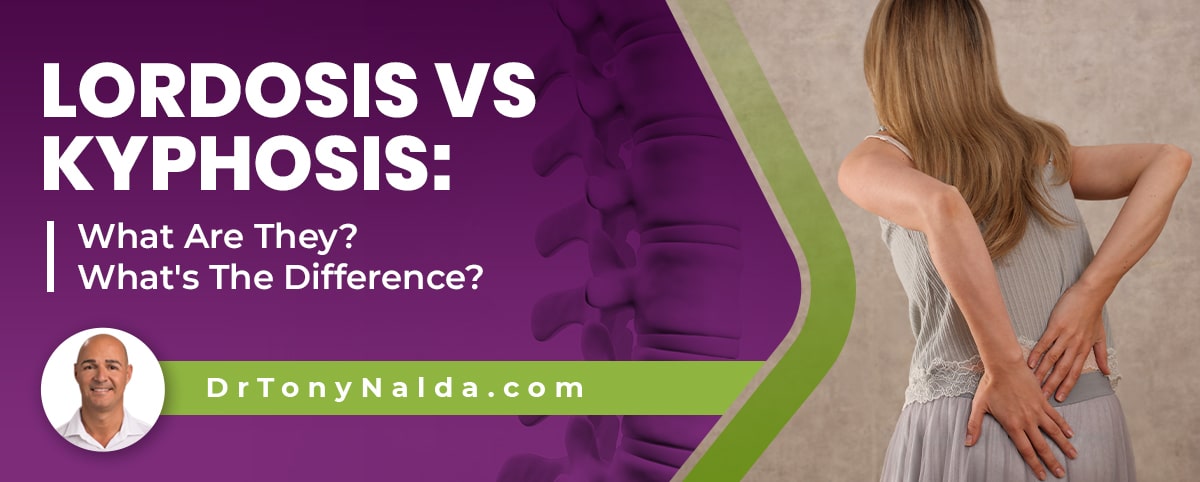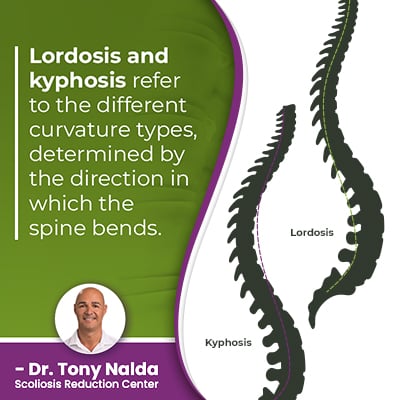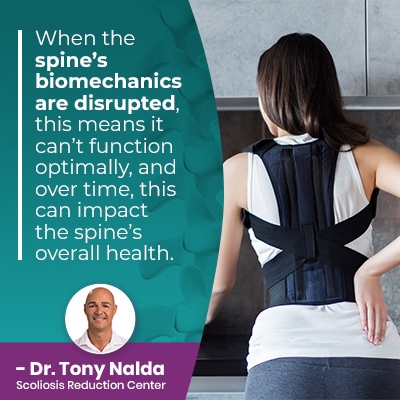Lordosis vs Kyphosis: What Are They? What's The Difference?

In order for the spine to stay healthy and function as it was designed to, it has to maintain its natural curves and alignment, meaning the vertebrae of the spine are stacked on top of one another in a straight and neutral alignment. Lordosis and kyphosis are opposite curvature types, and when healthy, both make the spine stronger, more flexible and functional, and when unhealthy, they can cause a number of effects felt throughout the body.
The spine’s natural curves help it function optimally. Lordosis and kyphosis are curvature types that can be natural and healthy, but if they are excessive, they become unnatural spinal curves such as hyperlordosis and hyperkyphosis. Lordotic curves bend inwards, while kyphotic curves bend outwards.
A healthy spine is aligned and has healthy degrees of both lordosis and kyphosis, so let’s start with some basic anatomy of a healthy spine.
Table of Contents
Anatomy of the Spine
A spine that has its curves in place is a spine that’s stronger, more flexible, and better able to absorb/distribute mechanical stress.
The spine’s natural and healthy curves give it a soft ‘S’ shape when viewed from the sides and will appear straight when viewed from the front and/or back.
When the spine’s healthy curves are in place, the vertebrae (bones of the spine) are aligned in a straight and neutral position, and each of the spine’s main sections has a characteristic curvature type: cervical spine (neck), thoracic spine (middle/upper back), and the lumbar spine (lower back).
In between adjacent vertebrae, an intervertebral disc provides cushioning, structure, and acts as the spine’s shock absorbers; disc deterioration can cause the development of a number of spinal conditions/issues.
In order for the spine to maintain its natural curves and alignment, it’s not just up to the spine itself; the spine’s surrounding muscles, ligaments, and individual structures, such as its discs, all work together to preserve its healthy curves.
So what are the different curvature types, and why are they important?
Lordosis and Kyphosis
 Lordosis and kyphosis refer to the different curvature types, determined by the direction in which the spine bends.
Lordosis and kyphosis refer to the different curvature types, determined by the direction in which the spine bends.
Lordosis refers to spinal curves that bend inwards, towards the body’s center, in a standard ‘C’ shape, and kyphosis refers to a spinal curve that bends outwards, away from the body’s center, in a reverse ‘C’ shape.
The cervical and lumbar spinal sections feature lordotic curves, while the thoracic spine has a natural kyphosis.
Now there is a natural range of these curvature sizes that can vary from person to person, and as long as the degree of curvature falls within a natural range, they are considered healthy, but if they fall beyond a normal range, becoming excessive, they are problematic and are diagnosed as either hyperlordosis or hyperkyphosis.
A healthy range of cervical lordosis falls between 20 and 40 degrees, and a healthy range of lumbar lordosis would fall between 40 and 60 degrees, while a healthy degree of thoracic kyphosis is also between 20 and 40 degrees.
So now that we’ve defined the terms and determined their primary difference, let’s talk about symptoms.
Hyperlordosis Symptoms
While each case is unique, some common symptoms of excessive lordosis include postural changes and pain:
- A swayback appearance due to the abdomen and buttocks protruding excessively
- The inability to lay on the floor with the lower back pressed flat into the floor (unnatural spinal curve means there is always a gap)
- Muscle pain
- Back pain
- Sciatica (due to compression of the sciatic nerve that starts in the lumbar spine)
- Mobility issues
So the main postural change and visual symptom of hyperlordosis is a swayback appearance, while hyperkyphosis causes a different postural change.
Hyperkyphosis Symptoms
As hyperkyphosis affects the thoracic spine, its main visual effect is causing a roundback appearance where the upper back and shoulders are excessively rounded forward.
In addition, hyperkyphosis is also known to cause the following symptoms:
- Tingling and/or numbness in the legs
- Excessive fatigue
- Breathing impairment
- Changes to balance
- Bladder and/or bowel issues
While the effects of spinal conditions can be felt throughout the body, in general, the area of the body located closest to the affected spinal section is going to be the most likely to feel the condition’s direct effects.
So hyperlordosis that most commonly affects the lumbar spine is going to most-directly affect the lower body, while hyperkyphosis that involves the thoracic spine is most likely to affect the upper body.
So now that we’ve also explored the different symptoms associated with excessive lordosis and kyphosis, let’s address whether both conditions can be present simultaneously.
Can a Person Have Both Excessive Lordosis and Kyphosis?
While the terms lordosis and kyphosis refer to opposite curvature types, one that bends inwards and one that bends outwards, it is possible for a person to experience excessive degrees of both lordosis and kyphosis simultaneously.
As the conditions involve different sections of the spine, with kyphosis affecting the thoracic spine and lordosis involving both the cervical and lumbar sections (most commonly the lumbar spine), it’s possible to have both exaggerated lordotic and kyphotic curves.
Interestingly enough, one of the ways the spine is known to respond to the loss of a healthy spinal curve is to put in an unhealthy curve in an attempt to counteract the uneven forces introduced by the first unnatural spinal curve; this is one of the ways in which an unnatural spinal curve can disrupt the biomechanics of the entire spine.
So excessive lordosis of the lumbar spine can be responded to by excessive kyphosis in the cervical section, as the spine tries to counteract the destabilizing forces of the first unnatural spinal curve.
 When the spine’s biomechanics are disrupted, this means it can’t function optimally, and over time, this can impact the spine’s overall health.
When the spine’s biomechanics are disrupted, this means it can’t function optimally, and over time, this can impact the spine’s overall health.
Are There Different Types of Hyperlordosis and Hyperkyphosis?
As is the case with a number of spinal conditions, there are also multiple condition types a person can develop, and type is commonly determined by a condition’s cause.
The main types of lordosis are postural, congenital, and post-surgical.
With postural lordosis, excessive lordosis develops because of chronic poor posture that, over time, can stretch the ligaments and muscles that support the spine, and cause the development of an unnatural spinal curve; carrying excess weight is also a contributing factor to postural lordosis.
Cases of congenital lordosis are caused by a malformed spine that develops in utero, meaning infants are born with the condition.
In post-surgical lordosis, a laminectomy (surgery that removes parts of the vertebral bodies) causes the spine to become unstable and develop excessive lordosis as a result.
When it comes to kyphosis, the most common types are postural, congenital, and Scheuermann’s.
Postural kyphosis is the simplest form to treat because it’s not structural in nature so can generally be addressed with lifestyle guidance and physical therapy.
Congenital kyphosis is a structural condition because it’s caused by a malformation within the spine itself that develops in utero.
Cases of Scheuermann’s kyphosis are more complex to treat because as a structural condition, it has to be impacted, first and foremost, on a structural level.
So as you can see, lordosis and kyphosis also share some common sources of causation.
Conclusion
The spine is a key structure of human anatomy; it allows us to stand upright, practice good posture, engage in flexible movement, protect internal organs, and it also works in tandem with the brain to form the body’s central nervous system.
In light of its many important functions, it’s clear how spinal conditions such as lordosis (hyperlordosis) and kyphosis (hyperkyphosis) can impact the body in many ways.
The spine’s natural curves are key to its optimal health and function, and while the size of a person’s spinal curves can vary, if curvature degrees fall beyond a normal range, this is when they become problematic and disrupt spinal biomechanics.
In fact, the health of each spinal section’s curvature type is dependent on the health of the others; the spine often responds to the development of an unnatural spinal curve by putting in a compensatory curve.
Lordosis refers to a spinal curve that bends inwards, towards the body’s center, at the cervical and lumbar spinal sections, while the term kyphosis refers to the spine’s outward curvature at the thoracic level.
While lordosis and kyphosis can refer both to healthy and unhealthy levels, hyperlordosis and hyperkyphosis indicate excessive degrees.
Hyperlordosis and hyperkyphosis affect the body differently in terms of postural changes; excessive lordosis causes a swayback appearance, while excessive kyphosis affects more of the upper body with a roundback appearance.
In addition, there are also different types of lordosis and kyphosis that share some common causes: postural and congenital.
Here at the Scoliosis Reduction Center, I’ve treated a wide range of spinal conditions, including lordosis and kyphosis, also known as hyperlordosis and hyperkyphosis, by customizing treatment plans around their underlying cause.
Dr. Tony Nalda
DOCTOR OF CHIROPRACTIC
After receiving an undergraduate degree in psychology and his Doctorate of Chiropractic from Life University, Dr. Nalda settled in Celebration, Florida and proceeded to build one of Central Florida’s most successful chiropractic clinics.
His experience with patients suffering from scoliosis, and the confusion and frustration they faced, led him to seek a specialty in scoliosis care. In 2006 he completed his Intensive Care Certification from CLEAR Institute, a leading scoliosis educational and certification center.
About Dr. Tony Nalda
 Ready to explore scoliosis treatment? Contact Us Now
Ready to explore scoliosis treatment? Contact Us Now





